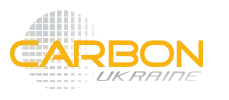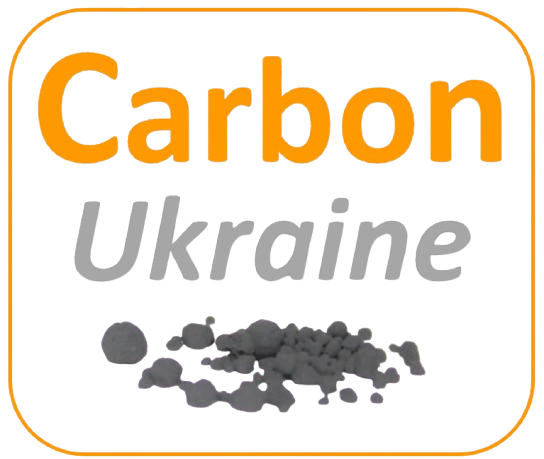Carbon-Ukraine - Equipment Manufacturing
NanoporeU Carbide Derived Carbon
 Carbide-derived carbon (CDC) is a nanoporous carbon produced by the extraction of metals from carbides. CDCs are produced at temperatures from 200-1200ºC as a powder, coating, a membrane or parts with near-final shapes, with or without mesopores.
Carbide-derived carbon (CDC) is a nanoporous carbon produced by the extraction of metals from carbides. CDCs are produced at temperatures from 200-1200ºC as a powder, coating, a membrane or parts with near-final shapes, with or without mesopores.
As precursors for carbide-derived carbon CDC synthesis we used different binary carbides – TiC, SiC, B4C, VC, Mo2C, NbC as well as ternary carbides, also known as MAX-phases, – Ti3AlC2, Ti2AlC, Mo2AlC, V2AlC and others.
A wide range of carbide precursors leads to a wide range of pore volumes and tailored properties. Total volume and characteristic dimensions of meso- and nanopores can be predicted and achieved by selection of a binary or ternary carbide and variation of the chlorination process parameters. Carbide derived carbons CDC can find applications in molecular sieves, gas storage, catalysts, adsorbents, battery electrodes, supercapacitors, water/air filters and medical devices.
A complete line of precisely manufactured specialty activated carbons custom-made to perform best in your application. Unlike hundreds of off-the-shelf carbon based commodity products, our carbon-derived carbon CDC allows activated carbon to be manufactured according to your needs and tuned to a specific application whether your product targets performance improvements in energy, water, medical, anlytical or other applications. With our carbide-derived carbon CDC, we have shown improvement in performance in several applications including supercapacitors, lithium ion batteries, gas (methane, hydrogen, chlorine, carbon dioxide, oxygen) storage, biocidial materials, thermal desorption, liquid chromatography, filtration, catalyst support and sorbents for sepsis treatment.
We are interested in partnering with you to develop carbide derived carbons specifically tailored to meet your needs. While developing the ‘best’ carbon for your application, we begin by thoroughly studying the underlying technology and the key materials properties required. Once we have an understanding of the properties required, we sample several small quantities of carbons for your evaluation and feedback. Below are some of our capabilities of custom-made carbide-derived carbon.
 Pore size of CDC – carbide-derived carbon
Pore size of CDC – carbide-derived carbon About Us
Technology
Our specialty carbon production process…
The development of commercial processes for producing specialty carbons is currently attracting attention across a wide range of industries. Carbon-Ukraine’s high-performance specialty carbon nanomaterials represent one of the most promising directions in this emerging field. Our production process allows for nanoscale control over carbon porosity. Carbon-Ukraine has developed a scalable, cost-effective platform for manufacturing porous carbon nanomaterials for a wide range of applications. Our carbons includes carbide derived carbon, polymer derived carbon and high purity activated carbon obtained from natural sources.
The carbide-derived carbon process involves etching metal atoms from metal carbides, e.g. removing Si atoms from SiC by etching with halogens, to produce porous carbons templated by the precursor carbide. Varying specific process parameters allows us to systematically control the structure and porosity of the carbon produced, resulting in a “tunable” materials system with a wide range of possible materials. Faster, more precise, and more controllable than the conventional multi-step pyrolytic processes employed to produce conventional activated carbons, Carbon-Ukraine carbide-derived carbon technology requires only a single step to produce highly-pure porous carbon.
The polymer-derived carbon process involves a two-step process; pyrolysis followed by activation. Polymer-derived carbon is very clean, dust free, and contains very little ash (less than 0.2%). Selection of different polymer precursors results in control of pore sizes, surface chemistry and particle shape. Spherical hard carbon particles can be used in applications such as flow capacitors where fast absorption capability, excellent wear resistance, and minimum pressure drop are desired.
Our commodity based activated carbon production process...
Our commodity-based activated carbons are primarily manufactured from three raw materials: fruit pits, coal and wood. Pyrolysis or carbonization and activation are the two major steps for producing activated carbons. The pyrolysis process involves removal of moisture and volatile matters from the raw material. In pyrolysis, the raw material is exposed to an inert atmosphere at 600 to 900°C. Once pyrolysis is completed, the “char” is activated. Activation results in creation of micro- and meso- pores. In the activation process, the “char” is exposed to activating agents such as carbon dioxide, steam, or potassium hydroxide, at temperatures between 600 to 1000°C.
Customization…
We can provide materials with specific properties optimized for a given application. Our engineers are experienced in determining the material characteristics needed for a variety of applications, while our process flexibility allows us to readily tune a material to offer optimal performance.
Below are some of our custom manufacturing capability:
• Narrow, broad, or hierarchical pore size distribution, with mean pore sizes from 0.6 to >20 nm are available
• High specific surface areas up to 2,000 square meters per gram and pore volumes up to 1 cubic centimeter per gram available
• A wide variety of form factors are possible, including micron-sized powders, nanopowders, spherical powders, coatings, monoliths, and fibers
• Systematic control over surface chemistry for tailoring sorption behavior and hydrophobicity/hydrophilicity
• Metals, metal oxide, metal carbide, and halogen inclusions can be retained in the final material to improve performance for a specific application


